S-20: Difference between revisions
Pbcjohnston (talk | contribs) Added photos |
Pbcjohnston (talk | contribs) Finished captions |
||
| Line 1: | Line 1: | ||
[[File:S-Boat Header 1.jpg]] | [[File:S-Boat Header 1.jpg]] | ||
=== External Photos === | |||
[[File:S-20 locks.jpg|left|500px]] | [[File:S-20 locks.jpg|left|500px]] | ||
<div style="text-align: justify;"><span style="color:#00008B">S-20 on one of her visits to the Panama Canal, locking through. There is just enough detail to show this is Panama. At the top left of the photo can be seen one of the "donkey" locomotives used to pull the vessels into and through the locks. | <div style="text-align: justify;"><span style="color:#00008B">S-20 on one of her visits to the Panama Canal, locking through. There is just enough detail to show this is Panama. At the top left of the photo can be seen one of the "donkey" locomotives used to pull the vessels into and through the locks. | ||
| Line 6: | Line 7: | ||
A lock gate can be seen on the left and behind the submarine is another and the lock behind is higher than the shown lock which means the submarine is descending to sea level. She may be in a center lock or the last lock. It is unclear which direction she is proceeding. | A lock gate can be seen on the left and behind the submarine is another and the lock behind is higher than the shown lock which means the submarine is descending to sea level. She may be in a center lock or the last lock. It is unclear which direction she is proceeding. | ||
The time frame is | The time frame is prior to her March 1924 to February 1925 conversion, when she became an engineering test platform, testing a variety of engine configurations. Her standard S-class bow was replaced with a radical new bow to test the sea keeping and submerged abilities of the new design. This type bow was to be used in the next class of submarines, the V-class and in a modified version was used in the later WWII boats and became known as a "fleet bow". | ||
<small>Photo from an original post card in the private collection of Ric Hedman</small> | <small>Photo from an original post card in the private collection of Ric Hedman</small> | ||
| Line 41: | Line 42: | ||
[[File:Red bar sub new.jpg]] | [[File:Red bar sub new.jpg]] | ||
[[File:S-20 fairwater.jpg|left|500px]] | |||
<div style="text-align: justify;"><span style="color:#00008B">The aft end of the S-20's fairwater, location is unknown, but this is a WWII era picture. In 1939 the Navy standardized on using the boat's hull number on the conning tower for identification purposes. S-20 spent the entire war operating out of New London engaged in training duties. Submarines permanently stationed stateside during the war retained their hull numbers on the conning tower to reduce the risk of friendly fire incidents. Submarines in the war zone in the Pacific carried no external identification at all. | |||
<small>Photo provided by Stan Lintner, from the Lintner Family Collection. Used with permission.</small> | |||
[[File:Red bar sub new.jpg]] | |||
[[File:S-20 surface bow.jpg|left|500px]] | |||
<div style="text-align: justify;"><span style="color:#00008B">S-20 bow viewed through the periscope. A fairly choppy sea can be seen running. This is a WWII era photo. | |||
<small>Photo provided by Stan Lintner, from the Lintner Family Collection. Used with permission.</small> | |||
[[File:Red bar sub new.jpg]] | |||
<div style="text-align: justify;"><span style="color:#000000"> | |||
=== Internal Photos === | |||
</div> | |||
[[File:S-20 int 1.jpg|left|500px]] | |||
<div style="text-align: justify;"><span style="color:#00008B">This and all of the following photos were taken aboard the S-20 during her operations out of New London during WWII. This photo shows the torpedo room looking forward. Crewmen are loading a torpedo. This process involved chain falls, roller skids, and a lot of old fashioned elbow grease. | |||
<small>Photo provided by Stan Lintner, from the Lintner Family Collection. Used with permission.</small> | |||
[[File:Red bar sub new.jpg]] | |||
[[File:S-20 int 2.jpg|left|500px]] | |||
<div style="text-align: justify;"><span style="color:#00008B">An officer entering S-20's torpedo room by stepping through the watertight door from the forward battery compartment. An awkward procedure at first, with practice it becomes routine. | |||
<small>Photo provided by Stan Lintner, from the Lintner Family Collection. Used with permission.</small> | |||
[[File:Red bar sub new.jpg]] | |||
[[File:S-20 int 4.jpg|left|500px]] | |||
<div style="text-align: justify;"><span style="color:#00008B">S-20's control room. A Quartermaster and the Navigator plot a position. | |||
<small>Photo provided by Stan Lintner, from the Lintner Family Collection. Used with permission.</small> | |||
[[File:Red bar sub new.jpg]] | |||
[[File:S-20 int 5.jpg|left|500px]] | |||
<div style="text-align: justify;"><span style="color:#00008B">The diving station in the control room. The Diving Officer keeps track of the bow and stern planesmen as they hold depth. The deep calibrated depth gauge is on the left, the shallow calibrated depth gauge is on the right. The S-20's maximum operating depth was 200 feet. | |||
<small>Photo provided by Stan Lintner, from the Lintner Family Collection. Used with permission.</small> | |||
[[File:Red bar sub new.jpg]] | |||
[[File:S-20 int 3.jpg|left|500px]] | |||
<div style="text-align: justify;"><span style="color:#00008B">The after battery berthing compartment, with sleeping men. The bunks in the center would trice up towards the overhead when not used, so that messing tables could be set up. | |||
<small>Photo provided by Stan Lintner, from the Lintner Family Collection. Used with permission.</small> | |||
[[File:Red bar sub new.jpg]] | |||
[[File:S-20 int 6.jpg|left|500px]] | |||
<div style="text-align: justify;"><span style="color:#00008B">Chow time on the S-20. This is the after battery berthing and messing compartment. You can see the bunk in the center has been triced up into the overhead to make way for the messing tables. | |||
<small>Photo provided by Stan Lintner, from the Lintner Family Collection. Used with permission.</small> | |||
[[File:Red bar sub new.jpg]] | |||
[[File:S-20 int 9.jpg|left|500px]] | |||
<div style="text-align: justify;"><span style="color:#00008B">The maneuvering room, in the forward end of the engine room. This panel is used to send electrical power from the generators to/from the batteries to the main motors for propulsion or charging the batteries. | |||
<small>Photo provided by Stan Lintner, from the Lintner Family Collection. Used with permission.</small> | |||
[[File:Red bar sub new.jpg]] | |||
[[File:S-20 int 10.jpg|left|500px]] | |||
<div style="text-align: justify;"><span style="color:#00008B">The other side of the maneuvering space, showing additional electrical distribution panels. | |||
<small>Photo provided by Stan Lintner, from the Lintner Family Collection. Used with permission.</small> | |||
[[File:Red bar sub new.jpg]] | |||
[[File:S-20 int 7.jpg|left|500px]] | |||
<div style="text-align: justify;"><span style="color:#00008B">S-20's engine room looking aft. The large object in the foreground is the ballast trim pump. | |||
<small>Photo provided by Stan Lintner, from the Lintner Family Collection. Used with permission.</small> | |||
[[File:Red bar sub new.jpg]] | |||
[[File:S-20 int 8.jpg|left|500px]] | |||
<div style="text-align: justify;"><span style="color:#00008B">Another view inside the S-20's engine room, this being outboard of the engines, probably the port side looking aft. The curve of the hull can be seen on the right. | |||
<small>Photo provided by Stan Lintner, from the Lintner Family Collection. Used with permission.</small> | |||
[[File:Red bar sub new.jpg]] | [[File:Red bar sub new.jpg]] | ||
Revision as of 20:02, 16 July 2023
External Photos
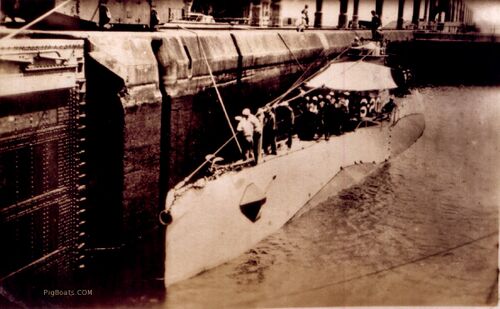
A lock gate can be seen on the left and behind the submarine is another and the lock behind is higher than the shown lock which means the submarine is descending to sea level. She may be in a center lock or the last lock. It is unclear which direction she is proceeding.
The time frame is prior to her March 1924 to February 1925 conversion, when she became an engineering test platform, testing a variety of engine configurations. Her standard S-class bow was replaced with a radical new bow to test the sea keeping and submerged abilities of the new design. This type bow was to be used in the next class of submarines, the V-class and in a modified version was used in the later WWII boats and became known as a "fleet bow".
Photo from an original post card in the private collection of Ric Hedman
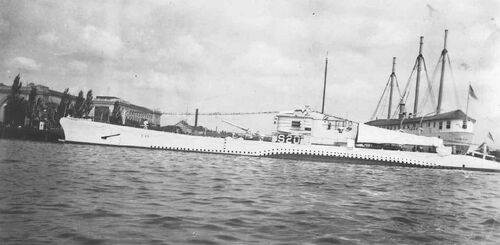
U.S. Navy photo
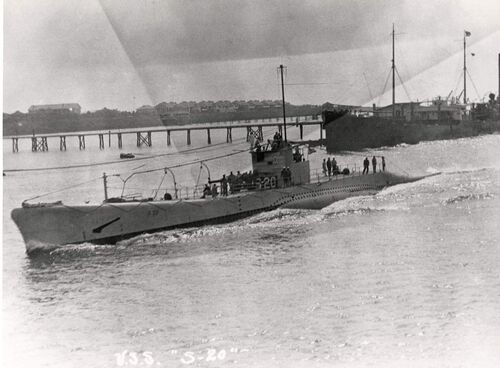
USN photo # NH 94167 via NHHC.
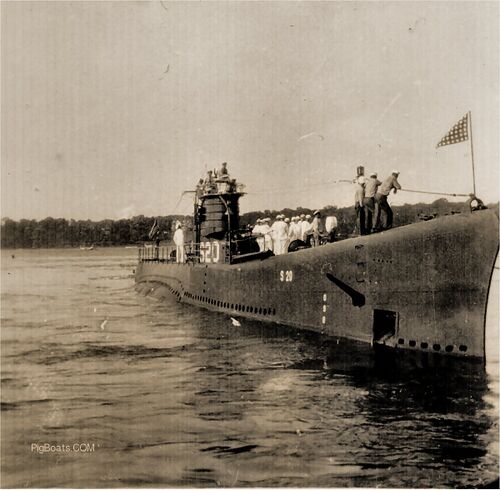
Note that the submarine is anchored. The anchor chain can be seen running out the anchor housing fairing. There are crew in both whites and dungarees on deck. A guess would be that liberty has been granted and the men are waiting for a launch to take them to the shore. Those not in whites are probably the duty section. This is just a theory since the real story is not known nor does it explain why there are so many officers on the bridge. Maybe the crew is returning from liberty and the sub is about to get underway.
Photo in the private collection of Ric Hedman

U.S. Navy photo

Photo provided by Stan Lintner, from the Lintner Family Collection. Used with permission.

Photo provided by Stan Lintner, from the Lintner Family Collection. Used with permission.
Internal Photos
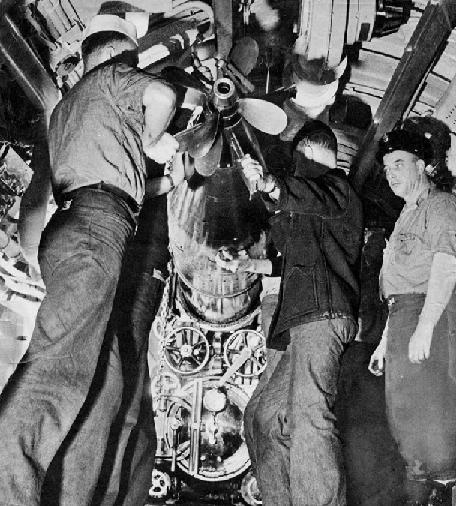
Photo provided by Stan Lintner, from the Lintner Family Collection. Used with permission.
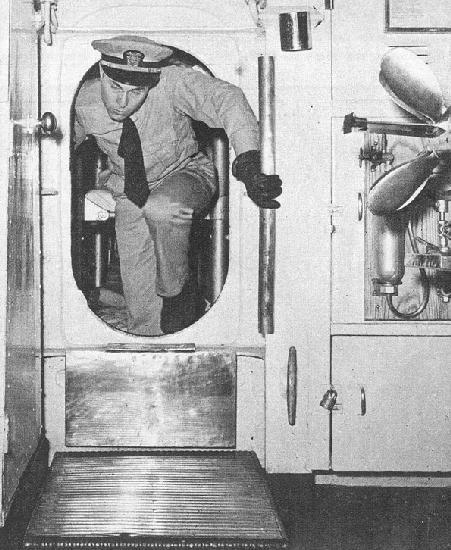
Photo provided by Stan Lintner, from the Lintner Family Collection. Used with permission.
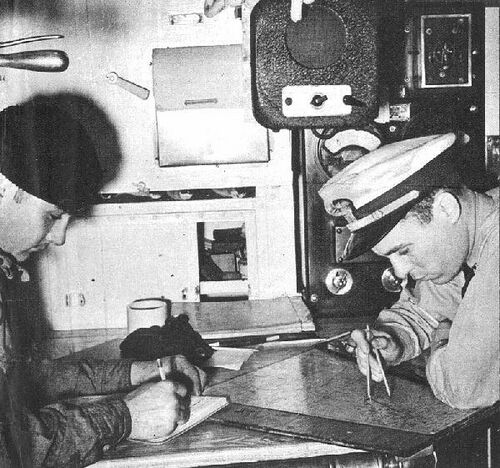
Photo provided by Stan Lintner, from the Lintner Family Collection. Used with permission.
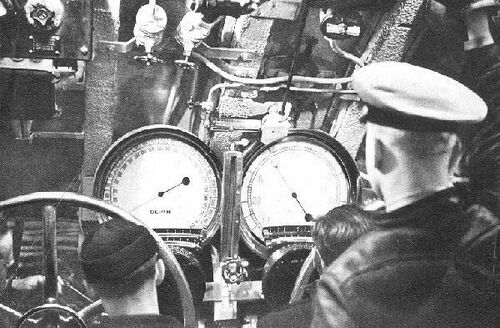
Photo provided by Stan Lintner, from the Lintner Family Collection. Used with permission.

Photo provided by Stan Lintner, from the Lintner Family Collection. Used with permission.
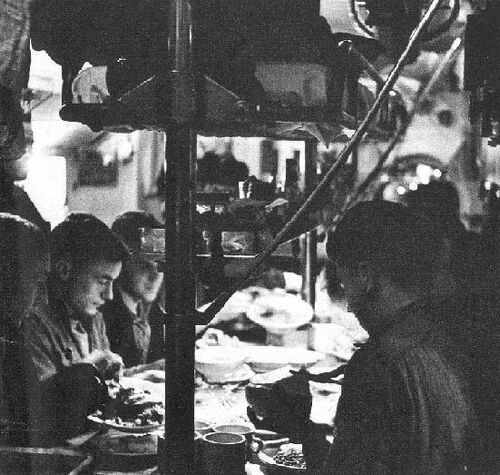
Photo provided by Stan Lintner, from the Lintner Family Collection. Used with permission.

Photo provided by Stan Lintner, from the Lintner Family Collection. Used with permission.
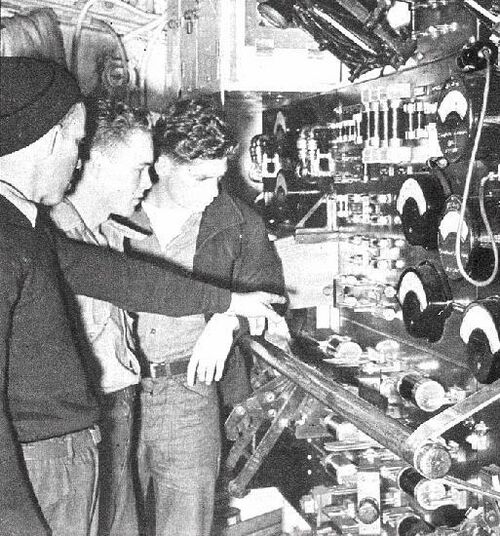
Photo provided by Stan Lintner, from the Lintner Family Collection. Used with permission.

Photo provided by Stan Lintner, from the Lintner Family Collection. Used with permission.

Photo provided by Stan Lintner, from the Lintner Family Collection. Used with permission.
Page created by:
Ric Hedman & David Johnston
1999 - 2023 - PigBoats.COM©
Mountlake Terrace, WA, Norfolk, VA
webmaster at pigboats dot com
